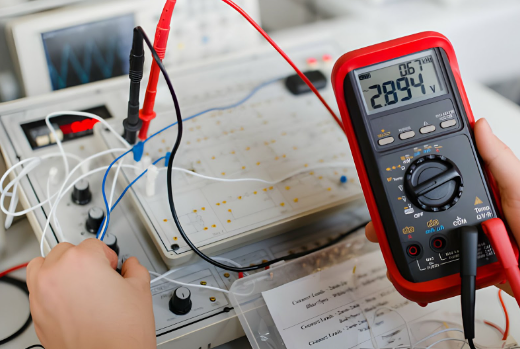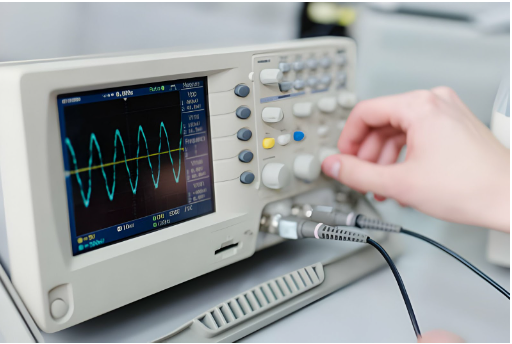
When it comes to testing and fixing electronics, there are two go-to tools – the oscilloscope and the digital multimeter. The key distinction between them is pretty straightforward: it’s all about “pictures vs. numbers.” Now, let’s dig into what that actually means in real-life situations and figure out when you should grab a digital multimeter and when it’s time to go for an online oscilloscope.
Digital Multimeter: Precision in Numbers

Digital multimeters are versatile devices designed for making precise measurements of discrete signals. With resolutions ranging from 3.5 to 4.5 digits, these handheld tools offer good accuracy and portability, making them ideal for front-line testing and general-purpose measurements.
The digital multimeter provides readings for voltage, current, and resistance, with some advanced models offering specialized functions such as min/max, conductance, relative reference, duty cycle/pulse width, and logging.
In addition to handheld versions, there are high-accuracy bench-type digital multimeters with resolutions of 5 to 8 digits. While not suitable for field use, these bench precision multimeters find their place in laboratories, aiding research and development or supporting production systems.
It’s worth noting that advanced bench precision multimeters can be as costly as portable oscilloscopes.
When to Use a Digital Multimeter
Front-line Testing: Digital multimeters are go-to tools for quick and precise measurements during front-line testing.
General-Purpose Measurements: For routine measurements of voltage, current, resistance, frequency, and other electrical parameters, a digital multimeter suffices.
Specialized Testing: Advanced functions make digital multimeters suitable for specialized testing, such as fast min/max tracking or duty cycle analysis.
(Also Read: How Does a Spectrum Analyzer Online Work? What Are Its Uses?)
Online Oscilloscope: Capturing the Visual Essence

In contrast to the digital multimeter’s numerical precision, oscilloscopes are designed to visually depict waveforms, providing a comprehensive picture of a signal’s characteristics. These tools are crucial for engineering work or troubleshooting systems with complex signals that operate at speeds beyond the capabilities of a digital multimeter.
While oscilloscopes may lack the same accuracy and resolution strength as multimeters, they compensate with faster measurement engines and broader bandwidths.
online oscilloscope , with resolutions equivalent to 3.5-to-4-digit multimeters, excel in displaying complex signals graphically. This visual representation allows for the identification of transient signals, potential threats to a system, and the visualization of distortion and noise in the signal.
When to Use an Oscilloscope
Quantitative and Qualitative Measurements: Oscilloscopes are indispensable when both numerical precision and visual representation are required.
Complex Systems Troubleshooting: For machine controls, intricate systems, or electronic design work, an oscilloscope is the tool of choice.
Industrial Applications: In industrial electronic applications, where signals can be complex, an oscilloscope with isolated inputs and sufficient bandwidth becomes essential.
Choosing the Right Tool for the Job
When starting any electrical project, it’s crucial to have a digital multimeter nearby. This handy tool lets you check voltage, current, resistance, frequency, and other electrical stuff with great accuracy. If the multimeter signals a problem by showing a red flag, it might be a sign to switch to an oscilloscope or another more advanced diagnostic tool.
For general-purpose maintenance or routine electronic testing, a digital multimeter is often sufficient. However, when delving into the troubleshooting of machine controls and complex systems or engaging in electronic design work, the unique capabilities of an oscilloscope become indispensable.
Specialized Applications for Oscilloscopes
Automation and Process Control: In these applications, an oscilloscope with two isolated inputs and bandwidths of 60 MHz, 100 MHz, or 200 MHz proves invaluable.
Machine Applications: For tasks such as measuring three-phase power electronics or comparing and contrasting multiple signals in three-axis control systems, an oscilloscope with four isolated input channels and 100 MHz or 200 MHz bandwidth is ideal.
Industrial Network Applications: Some oscilloscopes cater to industrial network needs by incorporating physical layer analog measurement algorithms to validate network health.
Final Thoughts
So, in the end, it really comes down to what you need for the job. The digital multimeter and the oscilloscope each have their own strong points. When you blend them together wisely, it’s like having a super team for testing and fixing electronics. Whether you’re dealing with everyday measurements or digging into the mysteries of complicated systems, having both a digital multimeter and an oscilloscope in your toolkit means you’re ready to tackle all sorts of challenges in the ever-changing world of electronics.
